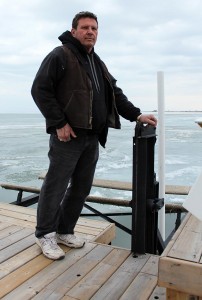Rising water levels good for society, frightens boaters

Longtime boater and lakeside resident, Mark Waters stands on his deck as ice from Lake St. Clair sweeps past its pillars in Lakeshore March 27, 2015. The huge chunks of ice make him nervous as the strong winds blew the ice into his neighbours dock and destroyed it. “I’m worried I won’t be able to get my boat in and out,” said Waters. Photo by Mandy Matthews
By Mandy Matthews
A windy day for the average downtown business person usually means a bad hair day, but during this time of year it means danger for some.
As the ice begins to melt and break, high winds shift the massive saucers towards shore.
This became evident to a few lakeside homeowners this week when large plates of ice started to pile up and cause destruction to their boat docks.
“It happened at three in the morning. All of the neighbours came outside. It sounded like a freight train,” said Mark Waters.
Waters grew up next to Lake St. Clair and has seen it all. He recalls a time in the 70s when the tide was so high, roads became beaches and basements became swimming pools.
It’s more dangerous, like just yesterday the ice started to move and almost took my dock out because the lake levels are higher now,” said Waters. “When the lake levels were lower the ice didn’t come in this far, it didn’t move. That’s the only thing I worry about.”
Water levels this year are higher than in years past, according to the Windsor Port Authority.
A report from the National Oceans and Atmospheric Administration states the Great Lakes are ranging from 25 to 50 centimetres above what they were at this time last year.
Current water levels have risen to a little higher than 175 metres. Just in the past month, the water accumulated marginally by 1.5 per cent.
[soundcloud url=”https://api.soundcloud.com/tracks/197994710″ params=”auto_play=false&hide_related=false&show_comments=true&show_user=true&show_reposts=false&visual=true” width=”100%” height=”450″ iframe=”true” /]
However, recreational boaters and homeowners have nothing to be concerned about according to Port Authority CEO, David Cree.
“It’s not an exact science,” said Cree. “When lake levels were down in 2013, it caused a significant inconvenience to commercial shipping and creates an impact on the recreational boater. We have also gotten to the point along the Detroit river where there was flooding back about ten years ago.”
He said the water level depends on the rain and how quickly the ice melts; especially on Lake Superior; where most of Detroit River’s watershed comes from. The Canadian Coast Guard is responsible for breaking up the ice in order for the shipping season to get on its way.
Waters said the Coast Guard seems to miss the residential areas.
“There’s a lot of benefits to the ice breaking that goes on, but unfortunately, there’s not an awful lot they can do about the guy who’s going to lose his dock,” said Cree.

Strong winds blew huge chunks of ice to the shore of Lake St. Clair March 27, 2015. Nearby docks were completely destroyed by the ice that piled up to one story high. Photo by Mandy Matthews
The Coast Guard did not respond in time for a comment.
Due to higher water, the ice, which usually piles up on the sandbars about a kilometre away from shore, is making walls a story high on people’s properties.
“Once it starts moving, there’s nothing that can stop it,” said Waters.
This poses almost no threat towards conservation areas and natural environments. The Essex Region Conservation Authority said while the water levels rise, the wetlands just adapt because it is used to the seasonal fluctuation.
Kevin Money, Director of Conservation Services, said the only real concern they would have is the spread of phragmites. This invasive grass plant lives in wetlands and throughout ditches in Windsor and Essex County.
“During low water levels, phragmites is able to quickly colonize and take over exposed mud flats. They can out compete other kinds of native species as well,” said Money. “Having high water levels would prevent the further spread of phragmites within coastal wetlands.”
Right now, the lakes are at the perfect level, said Cree. Higher water means steady commercial shipping. Two years ago, the Detroit River sunk dangerously low for cargo ships. Ground spots could be seen in Amherstburg.
When this happens, Cree said the vessels have to carry less cargo which leaves a bigger carbon footprint. With less cargo to build things, such as the Herb Gray Parkway, tax inflammation will ensue.
Charts provided by the Canadian Hydrographic Services show a five to ten year cycle for highs and lows. Since levels are increasing from last year, it is projected to be on an upward trend.
However, shipping season is starting one week later this year due to the amount of ice coverage over the winter. Ships are set to port on the 2nd of April.


